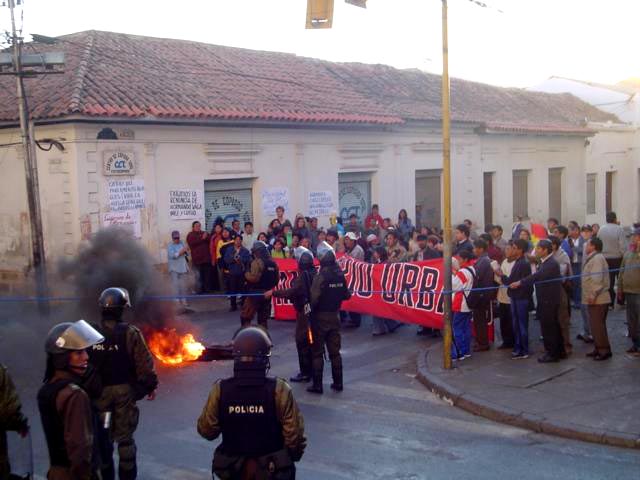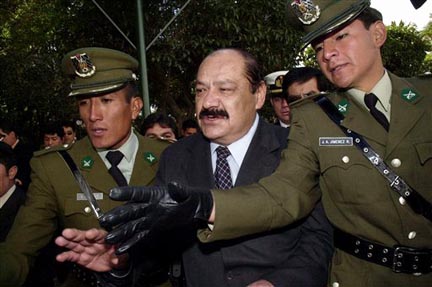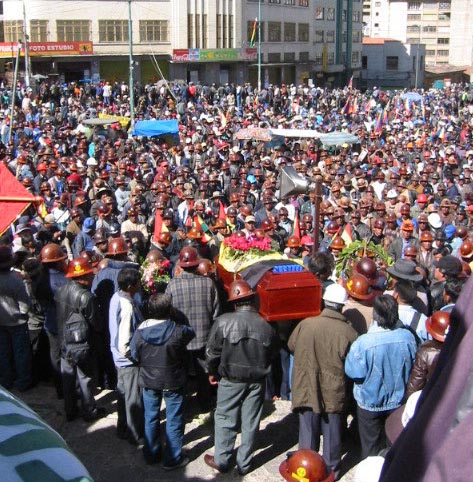
June 2005
Bourgeoisie Installs “Harvard Boy” Rodríguez
Bolivia Was “On Brink of Civil War”

Police face off with
teacher unionists in Sucre, early on June 9. Congress left La Paz to
install new
president, hoping to escape crowds of protesters. Instead, thousands of
miners, peasants and
workers converged on Bolivia’s second capital to block hardline
rightist Vaca
Díez from taking office.
(Photo: Indymedia Bolivia)
For a Workers,
Peasants and Indian Government!
June
9 was a day when Bolivia came to the edge of civil war, but the
bourgeoisie
suddenly pulled back from the brink. Faced
with the burgeoning mobilization of miners and
peasants, they
decided to switch tactics. Up to the last minute, right-wing forces
backed by
the U.S. embassy had been pushing to install hardliner Hormando Vaca
Díez as
president. They were happy to see Carlos Mesa go, blaming him for
failing to
defeat the mass demonstrations demanding nationalization of the
country’s oil
and gas resources. By the end of the day, just before midnight,
Congress swore
in a stop-gap president: Supreme Court head Eduardo Rodríguez.
“Harvard Boy”
Rodríguez, who has been an advisor to the U.S. embassy, was
proposed by Mesa
and Evo Morales, leader of the peasant-based Movement Toward Socialism
(MAS).
Bolivia’s rulers counted on Morales to demobilize his “troops” in
return, which
he did. By Friday morning, blockades were being lifted from roads
around the
country.
As
Thursday dawned, it looked like Bolivia was heading for a coup
d’état. Dressed
in battle fatigues and flanked by the rest of the Military High
Command,
Admiral Luis Aranda (Bolivia doesn’t have access to the sea, but it
does have a
Navy) announced at a morning press conference that the armed forces
were on a
“state of high alert” and prepared to “act if necessary.” On TV you
could see
behind the commander in chief a figure moving silently in the shadows.
It was
Gonzalo Valenzuela, a lawyer who was the advisor of the narco-dictator Luis García Mesa and who organized the
bloody repression of the 1985 miners’ “March for Life.” Aranda declared
that
the military (“the last bastion of the fatherland”) was opposed to
anything
that went against the constitution, including the proclamation of a
“National
Popular and Indigenous Assembly” the day before in El Alto.
Calling
on Bolivians to “avoid national suicide by calling a political and
social
truce,” a communiqué by the High Command pledged to defend the
“constitutional
succession.” The generals’ call on Congress to “listen to all the
actors who
are making their voices heard” was seen as an admonition to Vaca
Díez. As head
of the Senate he was first in line to succeed Mesa when Congress
convened in
Bolivia’s second capital, Sucre, later in the day. It was further
reported
that Mauricio Balcázar, brother in law of ex-president Gonzalo
Sánchez de
Lozada (“Goni”), as well as Eduardo Sfeir, a former advisor to the U.S.
embassy, traveled to Sucre on the plane with Vaca Díez.
Balcázar was at a
meeting in Washington in March, along with Goni and his “minister of
death,”
Carlos Sánchez Berzaín (Bolivia’s interior minister
during the October 2003
massacre), where a plot was hatched to install Vaca Díez as
president and oust
the “vacillating” Mesa.
 Hormando Vaca Díez arriving in Sucre
for emergency session of Congress, escorted by military officers, June
9. A few hours later he fled to army base to hide from demonstrators.
Hormando Vaca Díez arriving in Sucre
for emergency session of Congress, escorted by military officers, June
9. A few hours later he fled to army base to hide from demonstrators.
(Photo: Juan Karita/AP)
Vaca
Díez is a sinister figure. Backed by the same “mega-coalition”
that supported
the mass murderer Goni, he is a leader of the misnamed “Revolutionary
Left
Movement” (MIR). The latter was founded in 1971 amid the resistance to
the coup
by General Hugo Banzer, but in the 1980s became a junior partner in the
second
Banzer government. Vaca Díez was part of the wing of the MIR
linked to major
drug traffickers under the Banzer regime, and was implicated in
judicial
investigations of drug money funneled to MIR leader Jaime Paz Zamora.
Vaca Díez
earned the thanks of American ambassador David Greenlee by seeking to
legislate
immunity for U.S. forces in the country. (The bill failed in the face
of
vociferous opposition from workers and peasants.) In
recent days, the Senate president won embassy support for a
plan to declare a paper “nationalization” of gas and oil that left the
“multinational” energy companies in control, while cracking down on
protests.
What
Vaca Díez means by “imposing order” on the country was shown by
an incident in
March 2004. A distraught miner, Eustaquio Picachuri, “invaded” the main
hall of
Congress protesting against the pensions law which wiped out the
retirement of
several thousand former mine workers. The haughty response of Vaca
Díez was to
order the military to “remove that terrorist from my palace.” When
officials
sought to subdue him, Picachuri set off dynamite charges that blew him
apart.
The U.S. embassy hailed the “anti-terrorist” action of the Senate
president
that killed Picachuri. Vaca Díez is a senator from Santa Cruz in
the east and
is closely linked to the local oligarchy that finances fascistic goon
squads
that have viciously beaten Indian demonstrators.
With
the stage set for a “golpe blanco” (a “constitutional” or
“bloodless”
coup) or, “if necessary,” an outright military takeover, protest
actions spread
through the country as Congress was about to meet. Outgoing president
Mesa
warned of the danger of a blocked Congress, and the national police
chief said
Bolivia was “one step from civil war.” Miners marched in La Paz and El
Alto
denouncing the bourgeois parliament. The number of road blockades
reached 120
or more, paralyzing transport in most of the country. In La Paz, even
the
middle class polarized, with some neighborhood associations supporting
the
marchers and others organizing for “defense” against “those Indians.”
Although
Congressional leaders moved the vote to Sucre to escape the pressure of
the
masses in La Paz, thousands of workers and peasants began converging on
the
city. Sixty trucks filled with miners were reported on the way from
Oruro
alone. By mid-day Thursday, rather than a coup it appeared Bolivia
could indeed
erupt in civil war.
In
Sucre, soldiers were photographed bringing boxes of ammunition into the
legislative palace. As local workers marched on the Plaza 25 de Mayo,
police
kept them at bay by gassing the crowds. The angry opposition to Vaca
Díez’ power
grab was brought to the boiling point at 1:30 p.m. when army troops
shot and
killed a cooperative miners leader from Potosí, Juan Coro Mayta,
on the road
from Yatolo to Sucre. The La Paz daily La
Razón wrote with disdain of Mesa’s fear that a “muertito”
(one little dead person) could bring down the government.
Now a miner had been killed in order to install Vaca as president, and
the
masses erupted. A peasant leader from Chuquisaca declared, “Vaca
Díez will only
leave Sucre torn limb from limb.” The Senate leader fled to a military
base for
protection; other Senators sought refuge in the government palace or
hotels. By
6 p.m., it looked like Vaca could be lynched.
At
that point, Vaca called it quits and, no doubt after frenzied phone
calls with
the U.S. embassy in La Paz, the decision was made to appoint Eduardo
Rodríguez,
chief justice of Bolivia’s Supreme Court, as the new “constitutional”
president. In a hurried session of Congress, Rodríguez was sworn
in at a
quarter to midnight, without a presidential sash for the photographs,
and
received an embrace from Vaca Díez.
Evo
Morales and many other leaders of peasant and labor organizations had
seized on
the masses’ justified hatred of this belligerent rightist to focus
demands
on “No to Vaca,” setting the stage for yet another “negotiated
transition” to
yet another capitalist president to carry out the orders of U.S.
imperialism
and the local ruling class. Morales called for Rodríguez to be
named president
in order to organize early elections. Yet Rodríguez is not only
a political
associate of despised former president “Goni,” but a business associate
as
well: in his private practice the Harvard-educated lawyer defended
mining
companies owned by Sánchez de Lozada and his clan.
 Tens of thousands
attend symbolic funeral in La Paz June 10 for cooperative miners leader
Juan Coro Mayta killed by army on road to Sucre.
Tens of thousands
attend symbolic funeral in La Paz June 10 for cooperative miners leader
Juan Coro Mayta killed by army on road to Sucre.
(Internationalist photo)
Morales
and other leaders of the MAS called for a “truce” and an “intermission”
in the
struggle, to give Rodríguez time to carry out his “commitments.”
Yet Rodríguez,
like Mesa before him, has not said a word in favor of nationalizing the
gas and
oil companies, and the “accelerated” elections have yet to be scheduled.
So
after weeks of massive demonstrations against the Mesa government, road
blockades and running battles between protesters and the police and
army, what
comes out of it is … a Mesa II government. Right-wing politicians,
joined by La
Razón – still smarting over the failure of Vaca’s attempt to
grab the
presidency – point to agreements Mesa signed with cooperative mine
enterprises
in order to accuse him of using the cooperative miners to attempt
“genocide” – against the parliament!
For
their part, opportunists will declare this a “partial victory,” but
although
the extreme right-winger was blocked, another rightist oligarch was
installed
in his place. Meanwhile, many highway blockades are lifted and strikes
interrupted.
This is not any kind of a victory but a setback to the workers’ and
peasants’
struggles against the imperialists, their energy cartel and the
semicolonial
government that serves them. And whether or not the “intermission” is
brief or
extended, the fact is that this setback was prepared not only by
Morales, but
also by the sometimes militant-talking labor and peasant leaders who
sought
“unity” with the leader of the MAS and then cry “traitor” as he sells
out.
Morales is only doing what they all did in October 2003, and what he
did again
during the July 2004 referendum on gas, when he served once more as a
crucial
prop for Mesa. His is a betrayal long foretold.
In
March, the last time Mesa offered to resign as president, the COB union
federation, the MAS of Evo Morales, the CSUTCB of Felipe Quispe, the
Regional
Workers Federation (COR), Federation of Neighborhood Councils (Fejuve)
and
other organizations of El Alto joined in a “revolutionary unity pact”
against
“the multinationals and neoliberalism.” As soon as the new hydrocarbons
(gas
and oil) law was passed, this popular-front pact split and the
squabbling began
again. But they could get together in the first place because even the
reputed radicals limited their aims to (bourgeois) “democratic”
demands.
Calls for nationalization of gas and oil and a constituent assembly do
not go
beyond
the framework of bourgeois rule, nor does opposition to neoliberalism
and multinational capitalist enterprises. Morales could join with them
because
they were “united” in support of (reformed) capitalism.
Yet
capitalism in this epoch of imperialist decay cannot be reformed in the
interests of the exploited and oppressed. To rip Bolivia’s fabulous
mineral
resources away the imperialists, to genuinely enfranchise indigenous
peoples and
rescue
workers from the scourges of unemployment and rampant poverty will
require the
working class taking power and beginning the socialist revolution that
must
spread internationally to survive. It also requires telling the truth
to the masses:
namely, that substituting one capitalist puppet president for another
is no
victory for the working people of the countryside and the cities. A
Trotskyist
vanguard party of the proletariat must be built that
fights
against the bourgeoisie and also against the opportunists who guard its
left
flank. Otherwise, the betrayal of October 2003 will be followed by the
betrayal
of June 2005, with more to come.
In
La Paz demonstrations, the most radicalized sectors have chanted
“Workers to
power!” Yet the leaders of the labor and peasant organizations offer
truces and
“intermissions,” first to Mesa and now to Rodríguez. Morales
& Co. traffic
in poisonous anti-Chilean nationalism, all the while hoping
to cut a
behind-the-scenes deal with U.S. imperialism. The leader of the MAS
seeks
support from social-democratic head of government Lula in Brazil, who
is trying
to play his role as a fireman for Washington in putting out the flames
of
revolt in the region while the Brazilian state oil company acts as a
junior
partner of the imperialists in looting Bolivia’s gas and oil fields. In
contrast, a genuinely Trotskyist party would join with the workers of
Chile,
Brazil and throughout Latin America, as well as in the imperialist
centers, in
fighting for socialist revolution to sweep away the parliamentary dens
of
iniquity and replace them with the revolutionary rule of workers
councils.
For
a workers, peasants and Indian government in Bolivia, part of an Andean
federation of workers republics and a Socialist United States of Latin
America! n
To contact the Internationalist Group and the League for the Fourth International, send e-mail to: internationalistgroup@msn.com